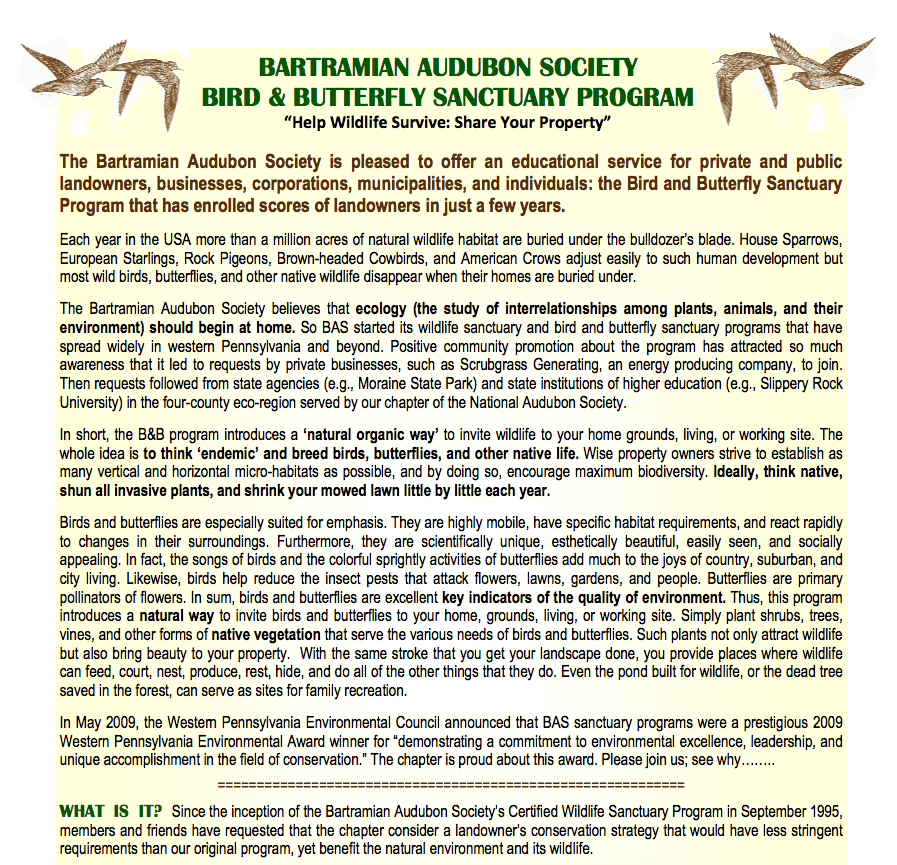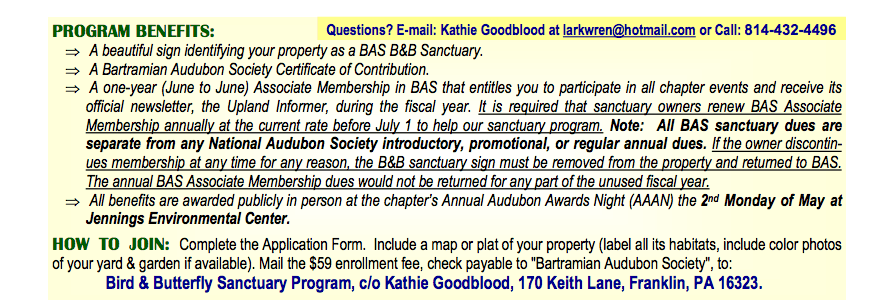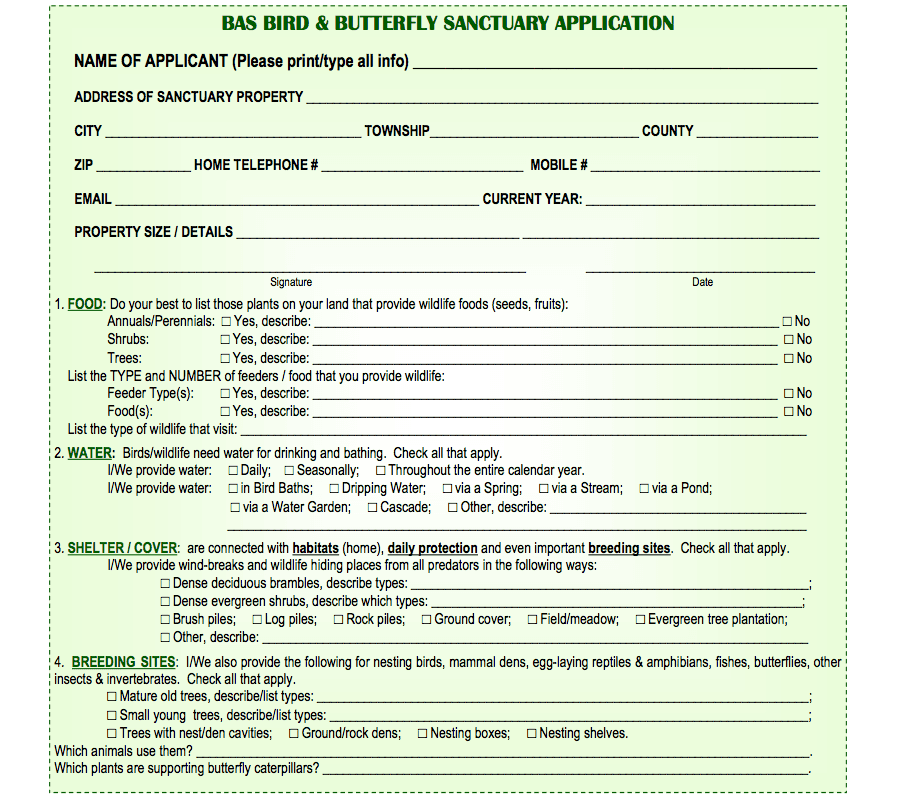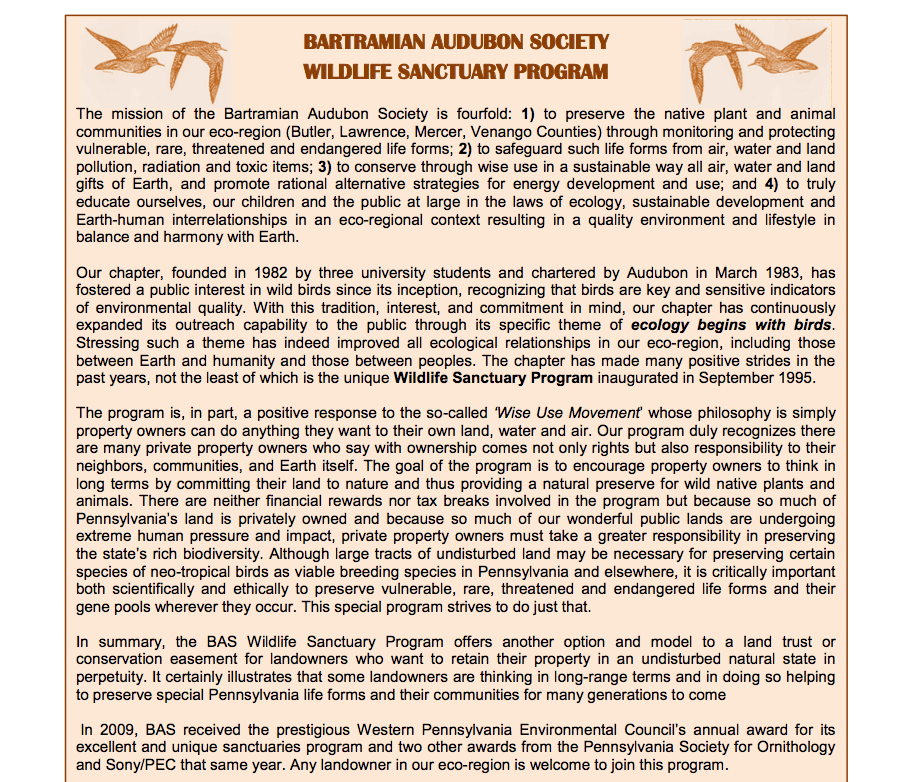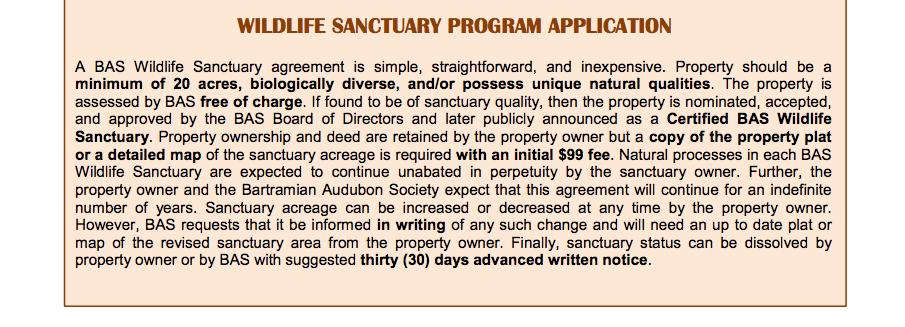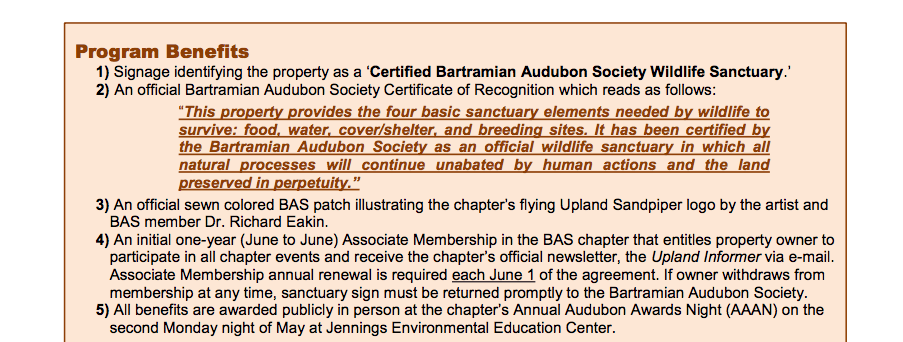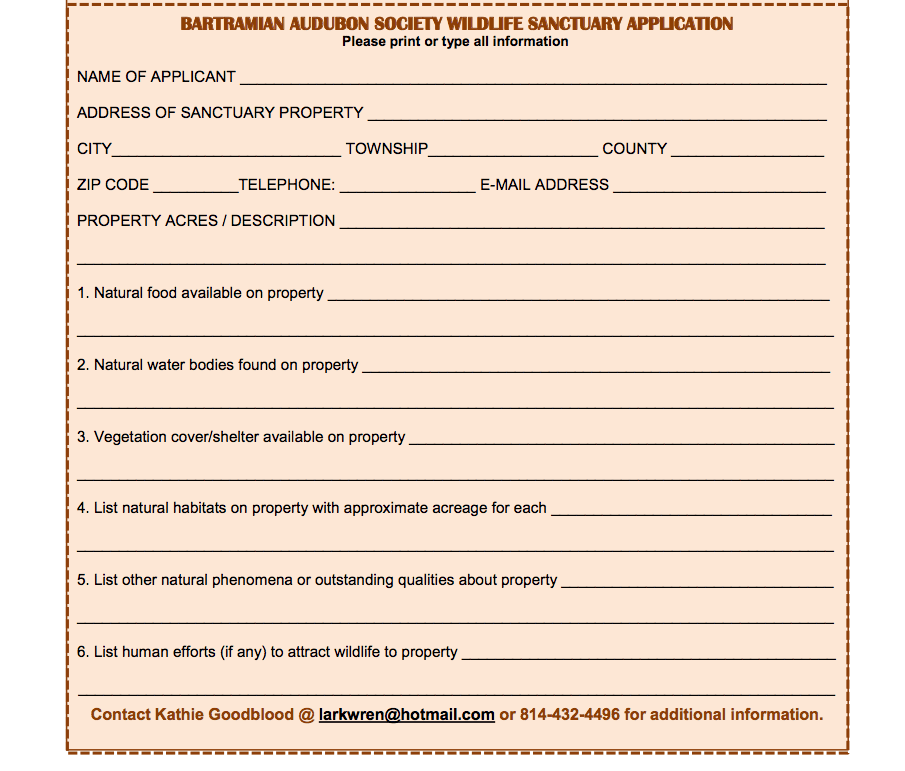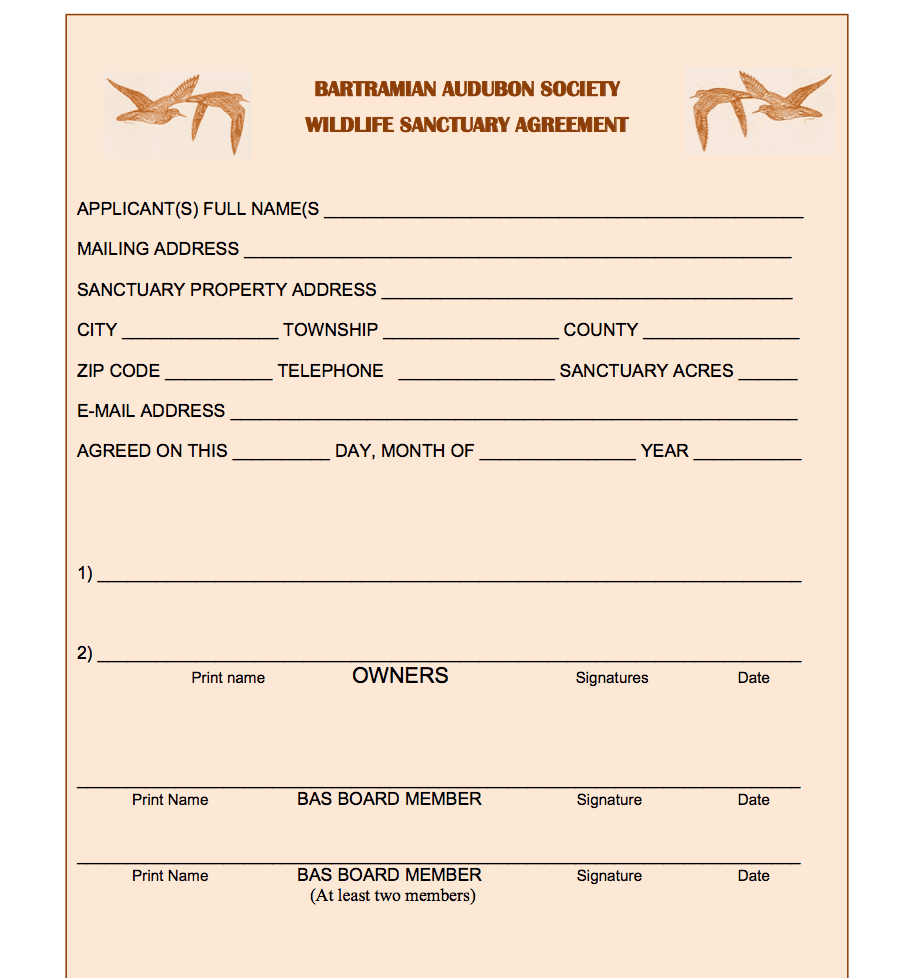BAS Wildlife Sanctuary Program
The mission of the Bartramian Audubon Society is fourfold:
1) to preserve the native plant and animal communities in our eco-region (Butler, Lawrence, Mercer, Venango Counties) through monitoring and protecting vulnerable, rare, threatened, and endangered life forms.
2) to safeguard such life forms from air, water, and land pollution, radiation, and toxic items.
3) to conserve through wise use in a sustainable way all air, water, and land gifts of Earth, and promote rational alternative strategies for energy development and use; and...
4) to truly educate ourselves, our children, and the public at large in the laws of ecology, sustainable development, and Earth-human interrelationships in an eco-regional context resulting in a quality environment and lifestyle in balance and harmony with Earth.
Our chapter, founded in 1982 by four university students and chartered by Audubon in March 1983, has fostered a public interest in wild birds since its inception, recognizing that birds are key and sensitive indicators of environmental quality. With this tradition, interest, and commit-ment in mind, our chapter has continuously expanded its outreach capability to the public through its specific theme that ecology begins with birds. Stressing such a theme has indeed improved all ecological interrelationships in our eco-region, including those between Earth and humanity and those between peoples.
The chapter has made many positive strides in the past 30 years, not the least of which is the unique Wildlife Sanctuary Program inaugurated in 1995. The program is, in part, a positive response to the so-called 'Wise Use Movement' whose philosophy is simply that property owners can do anything they want to their own land, water, and air. Our program duly recognizes that there are many private property owners who say that with ownership comes not only rights but also responsibility to their neighbors, communities, and Earth itself. The goal of the program is to encourage property owners to think in long terms by committing their land to nature and thus providing a natural preserve for wild native plants and animals.
There are neither financial rewards nor tax breaks involved in the program but because so much of Pennsylvania's land is privately owned and because so much of our wonderful public lands are undergoing extreme human pressure and impact, private property owners must take a greater responsibility in preserving the state's rich biodiversity. Although large tracts of undisturbed land may be necessary for preserving certain species of neo-tropical birds as viable breeding species in Pennsylvania and elsewhere, it is critically important both scientifically and ethically to preserve vulnerable, rare, threatened, and endangered life forms and their gene pools wherever they occur. This special program strives to do just that.
In sum, the BAS Wildlife Sanctuary Program offers another option and model to a land trust or conservation easement for landowners who want to retain their property in an undisturbed natural state in perpetuity. It certainly illustrates that some landowners are thinking in long-range terms and in doing so helping to preserve special Pennsylvania life forms and their communities for many generations to come. In 2009, BAS received the prestigious Western Pennsylvania Environmental Council's annual award for its excellent and unique sanctuaries program and two other awards from the Pennsylvania Society for Ornithology and Sony/PEC that same year.
A BAS Wildlife Sanctuary agreement is simple, straightforward, and inexpensive. Property should be a minimum of 20 acres, biologically diverse, and/or possess unique natural qualities. The property is assessed by BAS free of charge. If found to be of sanctuary quality, then the property is nominated, accepted, and approved by the BAS Board of Directors and publicly announced as a Certified BAS Wildlife Sanctuary. Property ownership, deed, and title are retained by the property owner but a copy of the property plat or a detailed map of the sanctuary acreage is required with an initial $99 fee. Natural processes in each BAS Wildlife Sanctuary are expected to continue unabated in perpetuity by the sanctuary owner.
Further, the property owner and the Bartramian Audubon Society expects that this agreement will continue for an indefinite number of years. Sanctuary acreage can be increased or decreased at any time by the property owner. However, BAS requests that it be informed in writing of any such change and will need an up to date plat or map of the revised sanctuary area from the property owner. Finally, sanctuary status can be dissolved by property owner or by BAS with suggested thirty (30) days advanced written notice.
Any landowner in our eco-region, private or public, is welcome to join this program.
Program Benefits
1) A beautiful wooden sign identifying property as a 'Certified Audubon Society Wildlife Sanctuary.'
2) An official Bartramian Audubon Society 'Certificate of Recognition.'*
3) A one-year (June to June) Associate Membership in the BAS chapter that entitles property owner to participate in all chapter events and receive the chapter's official newsletter, the Upland Informer. Renewed $15.00 Associate Membership is required each June of the agreement before the end of June.
4) All benefits are awarded publicly in person at the chapter's Annual Audubon Awards Night (AAAN) on the 2nd Monday evening of May at Jennings Center. *The Certificate of Recognition includes the following words: "This property provides the four basic sanctuary elements needed by wildlife to survive: food, water, cover/shelter, and breeding sites. It has been certified by the Bartramian Audubon Society as an official wildlife sanctuary in which all natural processes will continue unabated by human actions and the land preserved in perpetuity."
Download BAS Wildlife Sanctuary Program Application.
Click
HERE
BARTRAMIAN AUDUBON SOCIETY BIRD & BUTTERFLY SANCTUARY PROGRAM
"Help Wildlife Survive: Share Your Property" The Bartramian Audubon Society is pleased to offer an educational service for private and public landowners, businesses, corporations, municipalities, and individuals: the Bird and Butterfly Sanctuary Program that has enrolled scores of landowners in just a few years. Each year in the USA more than a million acres of natural wildlife habitat are buried under the bulldozer's blade. House Sparrows, European Starlings, Rock Pigeons, Brown-headed Cowbirds, and American Crows adjust easily to such human development but most wild birds, butterflies, and other native wildlife disappear when their homes are buried under.
The Bartramian Audubon Society believes that ecology (the study of interrelationships among plants, animals, and their environment) should begin at home. So BAS started its wildlife sanctuary and bird and butterfly sanctuary programs that have spread widely in western Pennsylvania and beyond. Positive community promotion about the program has attracted so much awareness that it led to requests by private businesses, such as Scrubgrass Generating, an energy producing company, to join. Then requests followed from state agencies (e.g., Moraine State Park) and state institutions of higher education (e.g., Slippery Rock University) in the four-county eco-region served by our chapter of the National Audubon Society. In short, the B&B program introduces a 'natural organic way' to invite wildlife to your home grounds, living, or working site.
The whole idea is to think 'endemic' and breed birds, butterflies, and other native life. Wise property owners strive to establish as many vertical and horizontal micro-habitats as possible, and by doing so, encourage maximum biodiversity. Ideally, think native, shun all invasive plants, and shrink your mowed lawn little by little each year. Birds and butterflies are especially suited for emphasis. They are highly mobile, have specific habitat requirements, and react rapidly to changes in their surroundings. Furthermore, they are scientifically unique, esthetically beautiful, easily seen, and socially appealing. In fact, the songs of birds and the colorful sprightly activities of butterflies add much to the joys of country, suburban, and city living.
Likewise, birds help reduce the insect pests that attack flowers, lawns, gardens, and people. Butterflies are primary pollinators of flowers. In sum, birds and butterflies are excellent key indicators of the quality of environment. Thus, this program introduces a natural way to invite birds and butterflies to your home, grounds, living, or working site. Simply plant shrubs, trees, vines, and other forms of native vegetation that serve the various needs of birds and butterflies. Such plants not only attract wildlife but also bring beauty to your property. With the same stroke that you get your landscape done, you provide places where wildlife can feed, court, nest, produce, rest, hide, and do all of the other things that they do. Even the pond built for wildlife, or the dead tree saved in the forest, can serve as sites for family recreation.
In May 2009, the Western Pennsylvania Environmental Council announced that BAS sanctuary programs were a prestigious 2009 Western Pennsylvania Environmental Award winner for "demonstrating a commitment to environmental excellence, leadership, and unique accomplishment in the field of conservation." The chapter is proud about this award.
Please join us; see why........ ============================ WHAT IS IT? Since the inception of the Bartramian Audubon Society's Certified Wildlife Sanctuary Program in September 1995, members and friends have requested that the chapter consider a landowner's conservation strategy that would have less stringent requirements than our original program, yet benefit the natural environment and its wildlife. WHY HAVE IT? Our chapter has fostered a public interest in wildlife, natural habitats, and biological diversity since its origin in 1983, recognizing that certain life forms are key and sensitive indicators of environmental quality. With this tradition, interest, and commitment in mind, the chapter has continuously expanded its outreach capability to the public through the specific theme that ECOLOGY BEGINS WITH BIRDS.
The chapter stresses ecological interrelationships in its eco-region of Butler, Lawrence, Mercer, and Venango Counties as illustrated by its many field trips and nearly monthly membership meetings. B&B PROGRAM: Therefore, based on requests, The BAS Board of Directors approved and inaugurated a Certified Bird and Butterfly Sanctuary Program in September 1997. Any landowner, private or public, is welcome to enroll in this program simply by agreeing not only to encourage wildlife (especially birds and butterflies) to use such property but also strive to improve or even inaugurate natural habitats and biodiversity there. This new conservation effort is a timely, beneficial, ecological complement to our already successful certified Wildlife Sanctuary Program emphasizing that "ecology truly begins at home." (over)


